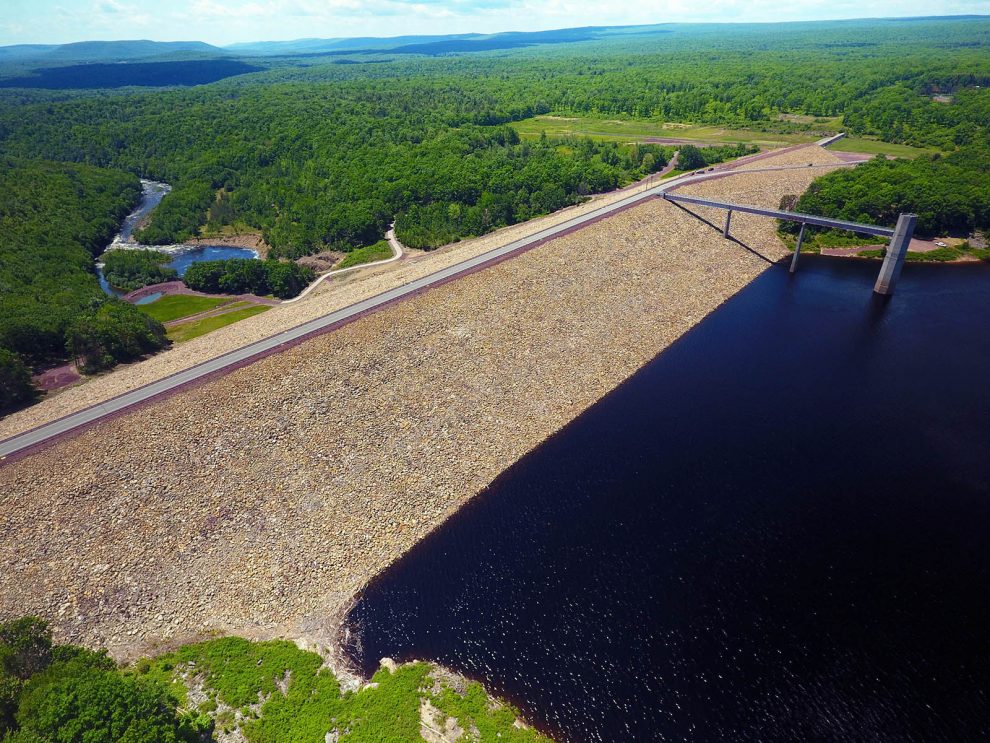By Tom Venesky • Special to The Current
There was a time when Ken Powley literally had to dodge bullets from angry landowners as he guided rafting trips down the Lehigh River. That was back in the 1970s when Powley started his business, Whitewater Challengers, and not everyone along the river was happy to see the fledgling business emerge.
Today, the bullets no longer fly, but a new threat has emerged that’s unlike anything Powley has ever faced during his five decades on the river.
One hundred miles away, the New York City Department of Environmental Protection is also facing a threat that is shaping up to be quite significant.
The agency is tasked with supplying drinking water — more than 1 billion gallons a day — to nine million customers in the city and surrounding areas. The city gets its drinking water from several reservoirs in the Catskills, but climate change has increased the risk of drought while, at the same time, raised the sea level, leading to a surge of saltwater pushing further up the Delaware River.
The very reservoirs that quench the thirst of New York City residents also feed the Delaware River, which must be maintained at specific levels to keep the “salt front” at bay.
Balancing the demands of supplying drinking water while ensuring enough freshwater surges down the Delaware to not only repel the salt, but to accommodate a thriving recreation industry, has resulted in a hefty burden on the upstate reservoirs.
The dilemma has led the NYC DEP to look elsewhere in the Delaware River Basin for more water, and the focus has settled on the Francis E. Walter Dam, which feeds the Lehigh River.
During the fall, the U.S. Army Corps of Engineers, which owns the dam, launched a study to determine if the impoundment can be used as a water supply to help push back the salt front and maintain the minimum flow targets on the Delaware.
The dam was built in 1961 for flood control, and recreation became a Congressionally-authorized use in 1988.
The study has a completion date of September 2022 and an estimated cost of $2.8 million. The USACE is funding half of that, while New York City ($897,000) and the Delaware River Basin Commission ($25,000 cash plus in-kind services to cover the balance) have partnered to fund the non-federal portion of the study.
And that has Powley worried.
If New York City gains control of the water behind the dam, it could doom the recreational industries on the Lehigh River, he said.
“I’ve seen a lot of threats and issues with the dam over the years, but nothing comes close to this,” Powley said. “Once downstream recreation was authorized as a use, and we got a flow plan to give us water releases, we thought that everything was stable.
“Maybe we were naïve. The thought that New York City would look at Francis Walter never crossed my mind.”
Powley’s White Haven-based business, which conducts weekend rafting excursions that coincide with water releases from the dam, has become a cornerstone of an industry that he said generates tens of millions of dollars into local economies along the river.
If New York City gained control of the water behind the dam, Powley said, recreation might not be a prioritized use and the water releases, and business, could dwindle.
But the potential impact isn’t limited to the river and rafts. Chris Barrett, CEO of the Pocono Mountains Visitors Bureau, said any change that impacts rafting and fishing on the river, along with the natural beauty, would have a devastating effect on tourism in the region, which includes Carbon, Monroe, Pike and Wayne counties.
The tourism industry, according to Barrett, generates $3.9 billion annually throughout the Pocono Mountains and is directly responsible for 35,000 jobs in the area.
Much of that financial benefit, and many of the jobs, he said, are related to the water from the dam that keeps the Lehigh River flowing.
“This plan can have a devastating impact on tourism and I wonder if everyone that has an interest in this is really aware of it,” Barrett said. “We need to sound the alarm bells.”
State Sen. John Yudichak, I-14, Plymouth Twp., is aware of the issue and is bothered by the idea of New York City potentially using water from Pennsylvania to meet its needs.
Francis Walter Dam and the Lehigh River are located in the heart of Yudichak’s district (Carbon and part of Luzerne counties), and he’s concerned about significant impacts to businesses in the area if water is used for something other than flood control and recreation.
“It doesn’t sit very well with me,” Yudichak said. “One of the frustrating things is we try to be good partners, however we see some neighboring states do things that aren’t in the best interest of Pennsylvania.
“If this plan isn’t in the best interest of Pennsylvania, we shouldn’t move forward. We’re going to put up a fight.”
Still, New York City officials insist they’re not looking for a battle and the study is simply exploratory.
According to NYC DEP Deputy Commissioner Paul Rush, one of the objectives of the study is to gauge the feasibility of adding “low flow augmentation” as a use for the dam. That means utilizing water behind the dam to flow into the Delaware River, via the Lehigh, to help prevent the salt front from advancing too far into the Delaware Estuary, which could threaten drinking water supplies.
Currently, the Delaware River Basin Commission monitors the flow of the river at Trenton, New Jersey, as a means to ensure enough water is coming down to repel the salt front.
New York City’s reservoirs in the Catskill Mountains provide water to meet the flow target at Trenton, and NYC DEP also utilizes water from the Blue Marsh and Beltzville reservoirs in Pennsylvania. Both reservoirs are owned by the USACE, but the commission owns storage in them for flow management purposes.
A similar scenario could be implemented for the Francis Walter Dam, depending on the outcome of the study.
Rush said the need to repel the salt front is more of an issue as opposed to gaining additional drinking water for the city. Water use in New York City and surrounding communities has decreased, from 1.6 billion gallons per day in 1979 to 1.1 billion gallons today.
The city is cognizant of the concerns of stakeholders who depend on the dam, Rush said, and the interests of all parties will be evaluated if any changes are proposed. Any approved change in the use of the dam could take years to implement, he added.
Francis Walter Dam is closer to Trenton and the Delaware Estuary than the reservoirs in upstate New York, which takes days for water to arrive and push back the salt front, according to Rush. By shifting some of that burden to the dam, it would allow New York to maintain higher levels of drinking water storage in its reservoirs, he said.
In addition to adding another use for the dam, different water storage levels and changes to infrastructure will also be considered under the study. But the movement of the salt front up the Delaware River is a growing concern, especially during times of drought when flows are low.
“Climate change is happening and this is something we need to look at,” Rush said. “Take a look at the dam and see if it can be done in a way to benefit the whitewater community, fisheries and all basin users, including New York City, to provide better protection against droughts in the future.
“This is something we identify as a possibility and my belief is that it can work.”
Tom Venesky is a freelance outdoors writer. He can be reached at www.veneskyoutdoors.com.



























Add Comment